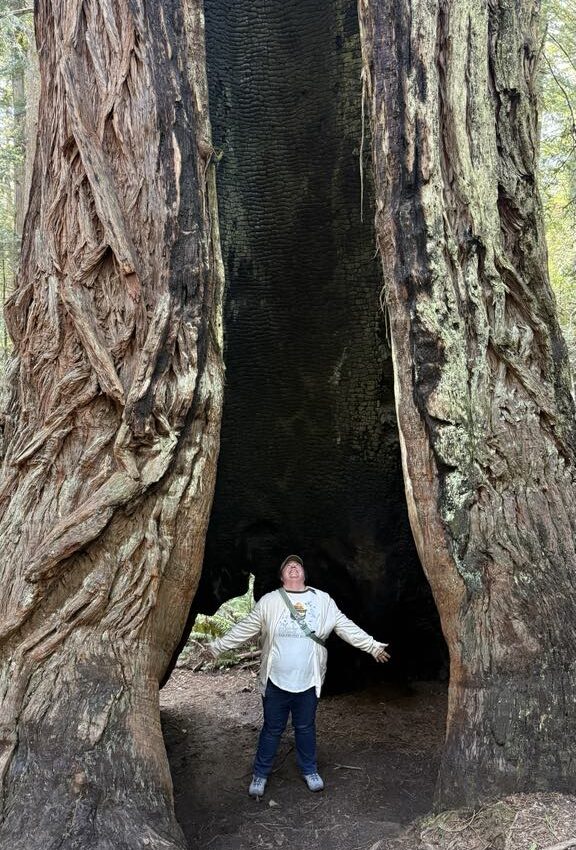On screen the audience sees an empty gravel lot behind the metal wall of a municipal sports arena. Where the crushed stone stops a line of arbor vitae protects the no-man’s-land strip of grass and the handful of buildings farther on, a hardware store, a furniture outlet. A bar of orange sunset remains in the sky, yet the streetlights are illuminated.
Zoom in to see the group of boys huddled in the corner near the shed with the dumpsters. The boy in the middle is older and stands taller than rest, who are fourteen years old, high schoolers for all of nine days now. They wear their apprehension like their overly large back-to-school sweatshirts. A breeze ruffles their hoods and scatters the leaves that have already forfeited to the approaching winter. Zoom in further on the boys’ faces with concerned eyebrows, focus on their hands fidgeting in anxiety.
“Huddle up, Lumberjacks,” says the tall one, the coach, and the team pulls in closer. “First game of the season. And we’re going to do whatever it takes to win.”
This makes everyone nervous, especially the audience. They don’t know if they’re seeing the end of the story, or the beginning. They also don’t yet know that the man filming this scene, the man crouched with a video camera behind some lilac bushes that line the back of sports complex, is the father of one of the boys.
Zoom out to a wide shot of the gravel expanse, with the scrum of hockey players off-center left. See the full effect of the wind on the browning rhododendrons behind them, and the maple trees above. Out of focus lilac limbs break into the frame at the urging of the impending cold front. The coach removes his backpack and sets it on the blacktop, then bends over to retrieve its contents.
Close-up of the backpack as seen through the boys’ legs. Tiny aluminum cans, one for each player. “This stuff is amazing. Tons of caffeine, and vitamin B12, and some chemical that’s like amphetamine, but it’s organic. We’re going to be so jacked up.”
One boy finds the courage to speak. “I can’t read it. What language is this?”
The coach points at the player. “Russian. It’s actually illegal to sell in stores.” He opens his can with a snap, and an effervescent fizz follows. “I get it through one of my trainers. But don’t worry, it’s totally safe.”
This reassures the team. The audience sees it in their posture and their sidelong glances at each other. The camera wavers, however. Is it intentional? Or is the filmmaker weighing his obligation to intervene? He can be responsible to his child or to his art, but not both.
“Ready?” says the coach. “We’ll do it together. On three.”
A montage of quick cuts: chugging, grimacing at the flavor, cans crushed in hands and underfoot, hockey players watching each other and the darkening sky as they assess whether or not they can feel any effects. And in the background, a sports music soundtrack. Rock and roll, bleacher stomping, crowds cheering.
“Tastes terrible,” says one of boys.
“I kind of like it,” responds another.
The coach shakes a few more drops out of his own can. “Sometimes this stuff can hit you pretty hard. If that happens, don’t freak out.” He returns his spent energy shot to his backpack. “Empties go in here, so we don’t get caught.”
A return to the wide angle gives the impression that the beverages are working. Some players giggle, others hop in place or shove their friends. A car drives by, and the boys turn away and huddle together as if facing the oncoming rush of an opposing team. The coach threads his arms through the straps of the backpack. “Everybody ready?”
His players step towards him. The audience understands that he has their trust. They look up to him. They adore him.
“Let’s suit up!”
The coach leads his team through the door in the back of the sports building. They shout and wave their fists like a marauding army. The camera remains still until the final teenager slips through and kicks away the empty sports drink bottle had been keeping the door propped open.
As the noise of the team fades, the audience becomes aware of a different sound. They can hear the cameraman’s slow, intentional breathing. In the simple white noise of the movement of air, they perceive that this is a story of youth hockey, the games and the players and their families, but it’s also a story of so much more.
A moment later the screen cuts to the same team on the rink, their game well underway. Three of the Lumberjack players occupy the penalty box. Another out on the ice has an opposing player on his back and punches the boy repeatedly, raising his fist above his head for each hit. A fifth Lumberjack clings to the back of a different opponent, riding the kid as he attempts to remain upright on his skates. The rest of the other team hover around the edges of the frame, compelled to aid their friends yet terrified of the viciousness they’re witnessing. The referees race to break up individual skirmishes, but new ones starts as soon as they extinguish the old ones.
On the far side of the rink, the other Lumberjacks stand on their bench or press into the boards, faces red, screaming, dots of spittle flying from their mouths. In the middle of a full-body shout, the boy in the center of the line stops. He looks away with eyes squinted in confusion, and when he lifts his head towards the ice again, his brows cross in panic and discomfort. With his arms clutching his stomach, he leans over the barrier and throws up onto the ice, pizza and breadsticks and a liquid the color of cherry cough syrup. The camera cuts to black, the title appears in white block letters to the sound of skates scraping on the ice. Then, the story begins.

Eric Rasmussen serves as fiction editor for Sundog Lit, as well as editor for the regional literary journal Barstow & Grand. He has placed short fiction in Fugue, Gulf Stream, Pithead Chapel, and South Carolina Review, among others. Find him online at theotherericrasmussen.com. Eric’s short story “The Next One After the Last” appears in Black Fox Issue 15.




Amazing! Palpable sense of tension and dread pull the reader right in!